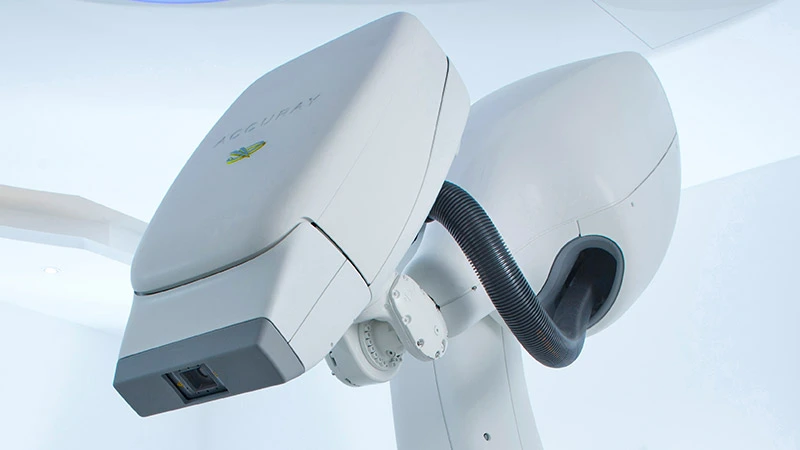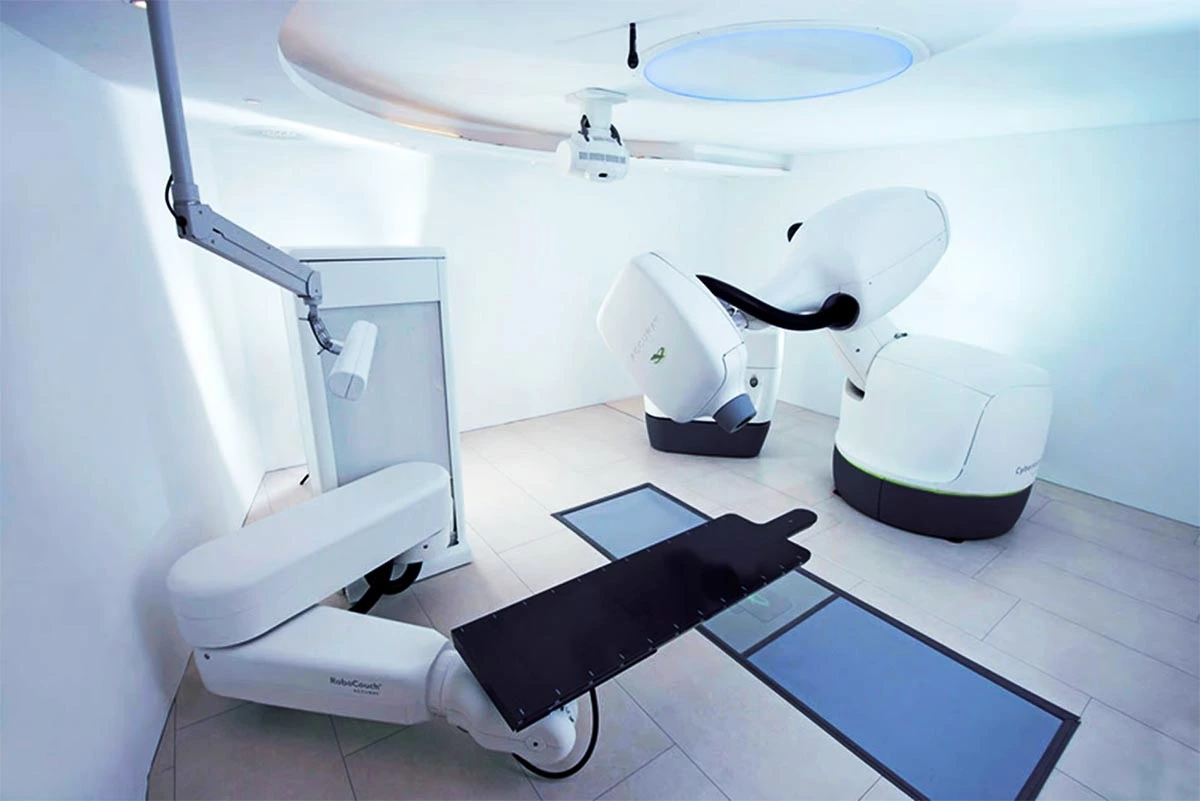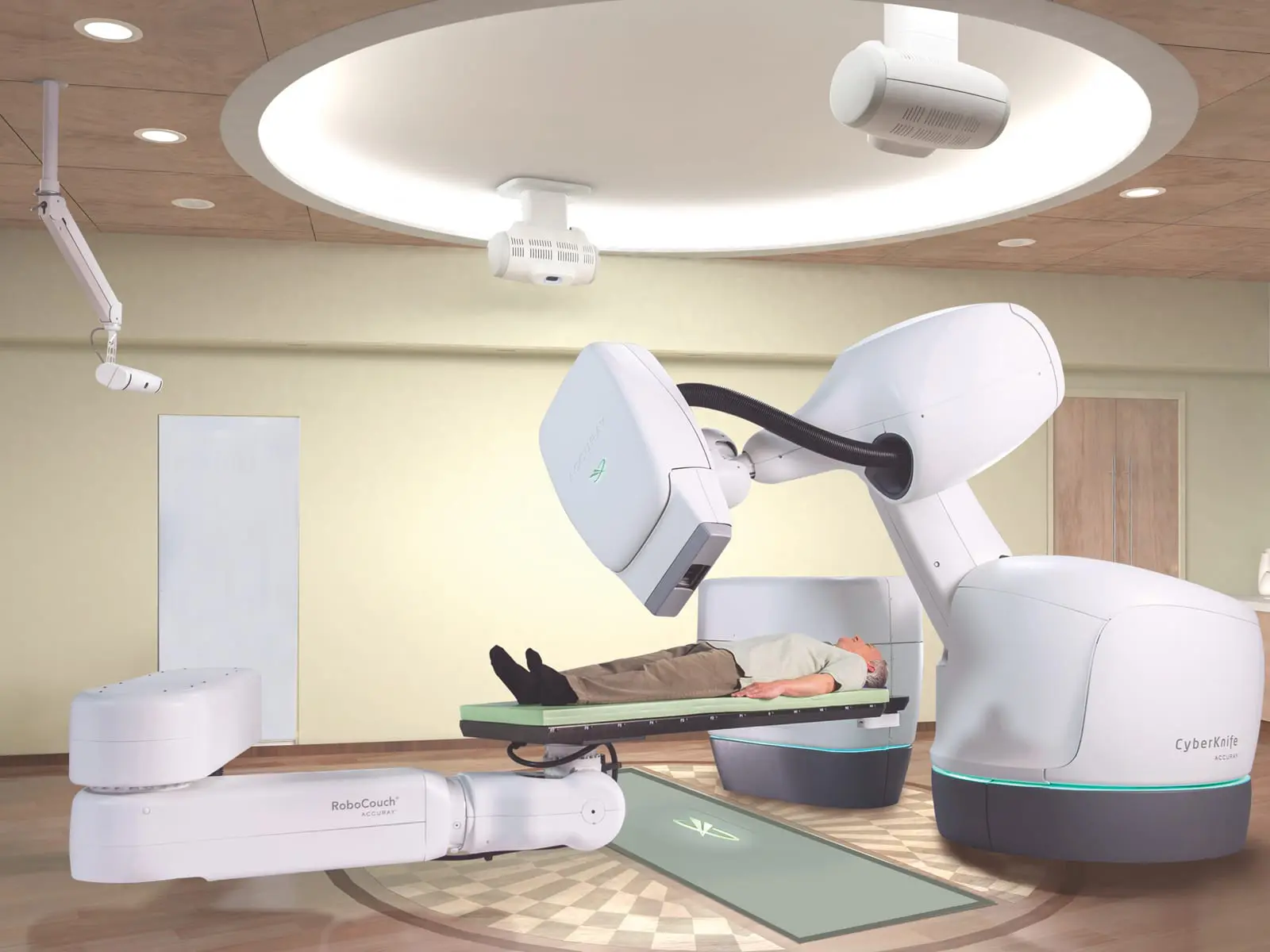Modern oncology is constantly searching for new, effective, and less invasive methods of tumor treatment, leading to the development of advanced medical technologies. One of such innovations is the CyberKnife system. CyberKnife treatment offers new possibilities in the fight against many malignant conditions. Its use allows targeting tumors located in virtually any part of the body, including hard-to-reach areas such as the brain, spine, lungs, and liver.
What is CyberKnife? This is a robotic radiosurgical system. Essentially, this is not a surgical tool in the conventional sense, but a high-precision robotic system capable of delivering powerful doses of radiation directly to the tumor with maximum accuracy, minimizing the impact on healthy tissue. These outstanding features make the method increasingly popular in the treatment of oncological diseases. Leading medical centers in Europe are actively implementing the use of CyberKnife radiation treatment, offering patients an advanced non-surgical alternative to traditional treatment methods, which significantly improves the outcomes of therapy and quality of life.
MedTour has been involved in medical tourism for a long time and actively cooperates with the best clinics in Europe that offer CyberKnife treatment. We will help you find the right medical center that treats your condition using the latest and most effective methods.
Would you like to receive a free consultation?
What is CyberKnife and how does it work?
CyberKnife is a high-tech system. This medical equipment provides non-surgical treatment of tumors by delivering powerful doses of radiation to the targeted area of the body. CyberKnife radiation treatment is based on a precision radiosurgical method that accurately destroys cancer cells. The CyberKnife system delivers stereotactic radiosurgery (SRS) and stereotactic body radiation therapy (SBRT).
CyberKnife consists of two main components:
- A small linear accelerator. It is the source of high-energy radiation.
- High-precision robotic manipulator (arm). This is a six-axis robotic manipulator that provides exceptional maneuverability and precision. The linear accelerator is mounted on the end of this robotic arm, enabling radiation beams to be directed at the tumor from hundreds of different angles.
How CyberKnife Works

The core principle of CyberKnife surgery is the delivery of high doses of radiation to a tumor from different directions, allowing for the concentration of maximum energy at the tumor site while significantly reducing exposure to surrounding healthy tissue. This is achieved through several specific features of the system:
- Mandatory 3D treatment planning. A three-dimensional model of the tumor and surrounding organs is created in advance to allow precise planning of the procedure. The optimal number and angle of each of the hundreds of radiation beams is calculated.
- Maximum radiation delivery accuracy. The linear accelerator mounted on a robotic arm can move around the patient, delivering radiation beams from any of 1,200 possible angles. This enables irradiation of the tumor from all directions, concentrating the maximum dose at the center of the tumor while minimizing exposure to surrounding healthy tissue.
- Real-time motion tracking system. This is one of the most outstanding advantages of the CyberKnife system. It detects even the slightest movements of the tumor caused by the patient’s breathing or other involuntary motions. If any displacement is detected, CyberKnife automatically adjusts the beam direction in real time. This ensures irradiation accuracy of up to 0.5-1 mm.
Would you like to receive a free consultation?
What conditions can be treated with CyberKnife?

CyberKnife radiation oncology can be used for both benign and malignant tumors, metastases, and other conditions that require radiotherapy.
The method is most often used for the following conditions:
- Brain tumors. Radiosurgery can be used for anaplastic astrocytoma, meningioma, vestibular schwannoma, pituitary adenoma, and other intracranial tumors.
- Spine and spinal cord tumors. Such as chondrosarcomas, hemangiomas, spinal cord neuromas, and spinal meningiomas.
- Lung tumors. Radiation therapy can be used for both primary lung cancer and pulmonary metastases.
- Liver tumors. CyberKnife can treat hepatocellular carcinoma and secondary (metastatic) liver cancer.
- Pancreatic tumors. Often used when the tumor is inoperable.
- Kidney tumors. Treatment is provided for both kidney cancer and kidney metastases.
- Prostate tumors. In the early stages of prostate cancer, CyberKnife radiation oncology may be an effective alternative to conventional radiation therapy or surgery.
- Tumors in the head and neck area. CyberKnife is used to treat tumors of the nasopharynx, larynx, oral cavity, base of the skull, and metastases in the lymph nodes of the neck.
And this is far from a complete list of indications where CyberKnife treatment is possible and justified. To find out whether this method would be effective for your condition, please contact a MedTour coordinating physician.
Would you like to receive a free consultation?
How does CyberKnife treatment work?
Treatment with the CyberKnife system is a carefully planned and highly precise process that takes place in several stages. Despite the common use of the term “CyberKnife surgery,” the procedure is actually non-surgical and does not require incisions, anesthesia, or hospitalization.
The CyberKnife treatment process includes the following stages:
- Initial diagnostics and consultation. At this stage, doctors review the results of previous diagnostics and treatments (such as biopsy, histology, surgeries, chemotherapy, radiation therapy, etc.) and may prescribe additional diagnostic methods to obtain the most accurate clinical picture (CT, MRI, PET-CT). Based on this, the optimal treatment strategy is selected for each individual patient.
- Planning of radiation therapy. Dosimetric planning is performed. The radiation targets and nearby critical structures are precisely identified. A detailed treatment plan is developed, calculating the radiation dose and the direction of the beams. The goal is to deliver the highest possible dose to the tumor while minimizing exposure to surrounding healthy tissue.
- Treatment procedure. At the beginning of the radiation session, the patient is positioned on a special CyberKnife treatment table. The robotic arm then begins to move around the patient, delivering radiation to the tumor according to the treatment plan. The system tracks the patient’s movements in real time and automatically adjusts the beams if the tumor shifts due to breathing or other motion. The procedure is painless and non-invasive, the patient feels only a slight noise from the device. One session usually lasts 30 minutes to 1 hour.
- Patient rehabilitation. After CyberKnife treatment, most patients can return to their normal activities immediately and can leave the clinic about 30 minutes after the session. However, the physician may provide individual recommendations. Follow-up appointments are usually scheduled to monitor progress. The effects of radiosurgery may appear gradually, over several months or even years. Regular follow-up ensures the effectiveness of treatment and allows timely adjustments, such as the addition of chemotherapy or immunotherapy.
Would you like to learn more information about CyberKnife treatment? Sign up for a free consultation with a MedTour coordinating doctor.
Would you like to receive a free consultation?
CyberKnife treatment cost in Europe
The cost of treatment with the CyberKnife system can vary significantly depending on a several factors, including:
- the level of the clinic;
- type of disease;
- tumor volume;
- tumor location;
- number of sessions required.
Additionally, prices for CyberKnife radiation treatment can vary significantly in different European countries:
- Czech Republic – from $10,000 per session;
- Spain – from $13,000 per session;
- Israel – from $12,000 per session;
- Germany – from $12,500 per session;
- United Kingdom – from $20,000 per session.
Please note that these are approximate figures. For accurate information on prices for the use of CyberKnife in European countries, please consult with a MedTour coordinating physician. You can also find out the cost of the CyberKnife treatment for various diseases in Turkey and Ukraine. Our specialist will provide information about clinics offering this service, alternative treatment options, and a detailed price list for medical services.
Would you like to receive a free consultation?
Advantages of CyberKnife Treatment

The CyberKnife system is one of the most advanced and effective methods in modern oncology and neurosurgery. This innovative technique offers a range of unique benefits that make CyberKnife a preferred choice for many patients, especially in cases when traditional surgery is risky or not possible.
Main benefits of CyberKnife radiation treatment:
- Non-invasive procedure. CyberKnife treatment is painless and does not require surgical incisions or anesthesia (in the vast majority of cases). This means no pain, no bleeding, no risk of infection, and no scarring.
- Exceptional precision. CyberKnife system delivers radiation with sub-millimeter accuracy (as precise as 0.5 – 1 mm) thanks to robotic technology and high-precision planning. This allows the radiation to be focused directly and exclusively on the tumor.
- Minimal impact on healthy tissue. Hundreds of low-energy radiation beams converge on the tumor from different angles, sparing the surrounding healthy tissue. This significantly reduces the risk of side effects.
- Effective treatment for hard to reach tumors. CyberKnife radiation oncology can effectively treat tumors located in anatomically complex or hard-to-reach locations (such as the base of the skull, near vital structures of the brain and spinal cord), where traditional surgery may be dangerous or impossible.
- An alternative for patients who cannot undergo surgery. CyberKnife is a life-saving option for patients who are contraindicated for surgical intervention due to age, concomitant diseases, poor general condition, or high anesthetic risk.
- Outpatient treatment. Most patients receive CyberKnife therapy on an outpatient basis and can return to their normal daily activities immediately after the session.
- Short treatment course. While traditional radiation therapy may take weeks, CyberKnife treatment typically requires only 1 to 5 sessions. This significantly reduces the overall treatment time and minimizes emotional stress.
- No rehabilitation period. Since the procedure is non-invasive, patients do not require a long recovery period. They can return to their normal lives almost immediately after treatment.
Would you like to receive a free consultation?
Where is CyberKnife surgery available in Europe?

Many of Europe’s leading medical centers are equipped with the CyberKnife system and offer radiosurgery as part of their treatment services. Below are some of the top clinics offering CyberKnife therapy:
- Teknon Medical Center (Spain). A world-renowned clinic, which in 2021 received the title of “World’s Best Hospitals 2021” according to Newsweek magazine, USA. The clinic is equipped with advanced medical equipment and actively uses stereotactic radiosurgery.
- Municipal Clinic Solingen (Germany). Ranked among the top best clinics in Germany. One of its key specialties is the treatment of oncological diseases.
- Nordwest Clinic (Germany). Featured in FOCUS magazine’s “Best Hospitals in Germany 2020” ranking.
- Barmbek (Germany). The clinic has received numerous international awards and is among the best medical institutions worldwide.
- Motol University Hospital (Czech Republic). SAK-certified and known for using advanced oncology treatments, including therapies for rare cancers.
- Sourasky Medical Center (Israel). It is considered one of the best hospitals in Israel and ranked among the top 50 best clinics in the world.
- Assuta Medical Center (Israel). The largest private clinic in Israel, globally recognized for its advanced cancer treatments, including CyberKnife therapy.
- Hadassah Medical Center (Israel). The leading hospital of Jerusalem. Oncology is one of its core departments, with advanced technologies including stereotactic surgery.
To get more information about clinics offering CyberKnife treatment or explore other effective treatment options for your condition, contact a MedTour coordinating doctor and receive a free consultation.
Would you like to receive a free consultation?
Frequently Asked Questions about CyberKnife
Is CyberKnife suitable for treating all types of tumors?
Although CyberKnife has a wide range of applications, like any medical method, it has its indications and limitations. When is CyberKnife not recommended? For example, there may be limitations based on tumor size. This method is most effective for treating small to medium tumors (up to 6 cm). Larger tumors typically require alternative treatment methods. Other important factors include the histological type of the tumor, its radiosensitivity, location, and disease spread. For instance, in cases of widespread metastases throughout the body, systemic therapies (such as chemotherapy, targeted therapy, or immunotherapy) are usually preferred, although CyberKnife can still be used to treat individual metastatic lesions.
How long does a CyberKnife treatment session last?
The duration of a session varies depending on the individual case and usually ranges from 30 minutes to 1.5 hours. The physician determines this based on the size and complexity of the tumor. Treatment may be completed in a single session or require several sessions.
Are there any side effects after treatment?
It is a non-invasive procedure and side effects are generally minimal. However, these can depend on the location of the tumor. The most common side effects include fatigue, headache (in cases of brain irradiation), nausea, or local skin reactions. These side effects typically resolve on their own or can be easily managed with medication.
During treatment, medical staff will be sure to warn you about possible side effects and help minimize their impact.
Would you like to receive a free consultation?
Do you have any questions?
Get a free consultation from our experts





